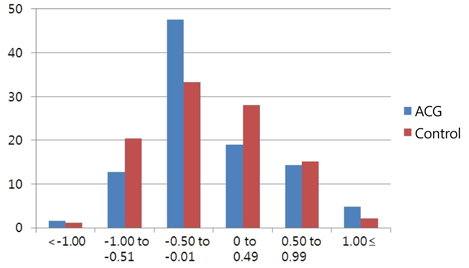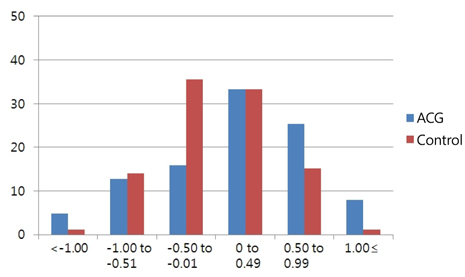Korean J Ophthalmol.
2011 Dec;25(6):375-379. 10.3341/kjo.2011.25.6.375.
Accuracy of Intraocular Lens Power Calculation Formulas in Primary Angle Closure Glaucoma
- Affiliations
-
- 1Department of Ophthalmology and Visual Science, Yeouido St. Mary's Hospital, The Catholic University of Korea College of Medicine, Seoul, Korea. sara514@catholic.ac.kr
- KMID: 1031183
- DOI: http://doi.org/10.3341/kjo.2011.25.6.375
Abstract
- PURPOSE
To compare the accuracy of intraocular lens (IOL) power calculation formulas in eyes with primary angle closure glaucoma (ACG).
METHODS
This retrospective study compared the refractive outcomes of 63 eyes with primary ACG with the results of 93 eyes with normal open angles undergoing uneventful cataract surgery. Anterior segment biometry including anterior chamber depth, axial length, and anterior chamber depth to axial length ratio were compared by the IOL Master. Third generation formulas (Hoffer Q and SRK/T) and a fourth generation formula (Haigis) were used to predict IOL powers in both groups. The predictive accuracy of the formulas was analyzed by comparison of the mean error and the mean absolute error (MAE).
RESULTS
In ACG patients, anterior chamber depth and the anterior chamber depth to axial length ratio were smaller than normal controls (all p < 0.05). The MAEs from the ACG group were larger than that from the control group in the Haigis formula. The mean absolute error from the Haigis formula was the largest and the mean absolute error from the Hoffer Q formula was the smallest.
CONCLUSIONS
IOL power prediction may be inaccurate in ACG patients. The Haigis formula produced more inaccurate results in ACG patients, and it is more appropriate to use the Hoffer Q formula to predict IOL powers in eyes with primary ACG.
Keyword
MeSH Terms
Figure
Cited by 2 articles
-
Effects of Choroidal Thickness on Refractive Outcome Following Cataract Surgery in Primary Angle Closure
Woo Keun Song, Kyung Rim Sung, Joong Won Shin, Junki Kwon
Korean J Ophthalmol. 2018;32(5):382-390. doi: 10.3341/kjo.2017.0129.Refractory Outcomes after Cataract Surgery in Acute Primary Angle-closure Glaucoma Patients Treated with Laser Iridotomy
Hye Seong Hwang, Dong Yoon Kim, Hyun Tae Kim, Ju Byung Chae, Sungmin Hyung
J Korean Ophthalmol Soc. 2019;60(5):447-454. doi: 10.3341/jkos.2019.60.5.447.
Reference
-
1. Drexler W, Findl O, Menapace R, et al. Partial coherence interferometry: a novel approach to biometry in cataract surgery. Am J Ophthalmol. 1998. 126:524–534.2. Lee AC, Qazi MA, Pepose JS. Biometry and intraocular lens power calculation. Curr Opin Ophthalmol. 2008. 19:13–17.3. Terzi E, Wang L, Kohnen T. Accuracy of modern intraocular lens power calculation formulas in refractive lens exchange for high myopia and high hyperopia. J Cataract Refract Surg. 2009. 35:1181–1189.4. Ucakhan OO, Ozkan M, Kanpolat A. Anterior chamber parameters measured by the Pentacam CES after uneventful phacoemulsification in normotensive eyes. Acta Ophthalmol. 2009. 87:544–548.5. Nonaka A, Kondo T, Kikuchi M, et al. Angle widening and alteration of ciliary process configuration after cataract surgery for primary angle closure. Ophthalmology. 2006. 113:437–441.6. Hayashi K, Hayashi H, Nakao F, Hayashi F. Changes in anterior chamber angle width and depth after intraocular lens implantation in eyes with glaucoma. Ophthalmology. 2000. 107:698–703.7. Yang CH, Hung PT. Intraocular lens position and anterior chamber angle changes after cataract extraction in eyes with primary angle-closure glaucoma. J Cataract Refract Surg. 1997. 23:1109–1113.8. Law SK, Mansury AM, Vasudev D, Caprioli J. Effects of combined cataract surgery and trabeculectomy with mitomycin C on ocular dimensions. Br J Ophthalmol. 2005. 89:1021–1025.9. Francis BA, Wang M, Lei H, et al. Changes in axial length following trabeculectomy and glaucoma drainage device surgery. Br J Ophthalmol. 2005. 89:17–20.10. Kang SY, Hong S, Won JB, et al. Inaccuracy of intraocular lens power prediction for cataract surgery in angle-closure glaucoma. Yonsei Med J. 2009. 50:206–210.11. Santodomingo-Rubido J, Mallen EA, Gilmartin B, Wolffsohn JS. A new non-contact optical device for ocular biometry. Br J Ophthalmol. 2002. 86:458–462.12. Findl O, Drexler W, Menapace R, et al. High precision biometry of pseudophakic eyes using partial coherence interferometry. J Cataract Refract Surg. 1998. 24:1087–1093.13. Haigis W, Lege B, Miller N, Schneider B. Comparison of immersion ultrasound biometry and partial coherence interferometry for intraocular lens calculation according to Haigis. Graefes Arch Clin Exp Ophthalmol. 2000. 238:765–773.14. Charalampidou S, Cassidy L, Ng E, et al. Effect on refractive outcomes after cataract surgery of intraocular lens constant personalization using the Haigis formula. J Cataract Refract Surg. 2010. 36:1081–1089.15. Elder MJ. Predicting the refractive outcome after cataract surgery: the comparison of different IOLs and SRK-II v SRK-T. Br J Ophthalmol. 2002. 86:620–622.16. Marchini G, Pagliarusco A, Toscano A, et al. Ultrasound biomicroscopic and conventional ultrasonographic study of ocular dimensions in primary angle-closure glaucoma. Ophthalmology. 1998. 105:2091–2098.17. Lowe RF. Causes of shallow anterior chamber in primary angle-closure glaucoma. Ultrasonic biometry of normal and angle-closure glaucoma eyes. Am J Ophthalmol. 1969. 67:87–93.18. Narvaez J, Zimmerman G, Stulting RD, Chang DH. Accuracy of intraocular lens power prediction using the Hoffer Q, Holladay 1, Holladay 2, and SRK/T formulas. J Cataract Refract Surg. 2006. 32:2050–2053.19. Hoffer KJ. The Hoffer Q formula: a comparison of theoretic and regression formulas. J Cataract Refract Surg. 1993. 19:700–712.20. Haigis W. IOL power calculations. Ophthalmology. 2010. 117:400–401.21. Gavin EA, Hammond CJ. Intraocular lens power calculation in short eyes. Eye (Lond). 2008. 22:935–938.22. MacLaren RE, Natkunarajah M, Riaz Y, et al. Biometry and formula accuracy with intraocular lenses used for cataract surgery in extreme hyperopia. Am J Ophthalmol. 2007. 143:920–931.
- Full Text Links
- Actions
-
Cited
- CITED
-
- Close
- Share
- Similar articles
-
- Comparison of the SRK and SRKII Formulas with Revision of Constant A in Intraocular Lens Power Calculation
- Evaluation for the Accuracy of the SRK/T Formula in PCL Implanted Patients(I)
- Comparison of Accuracy of Six Modern Intraocular Lens Power Calculation Formulas
- Difference Between Postoperative Refraction and Predictive Refraction after Cataract Operation in Patients with Coexisting Cataract and Primary Angle-closure Glaucoma
- Inaccuracy of Intraocular Lens Power Prediction for Cataract Surgery in Angle-Closure Glaucoma




